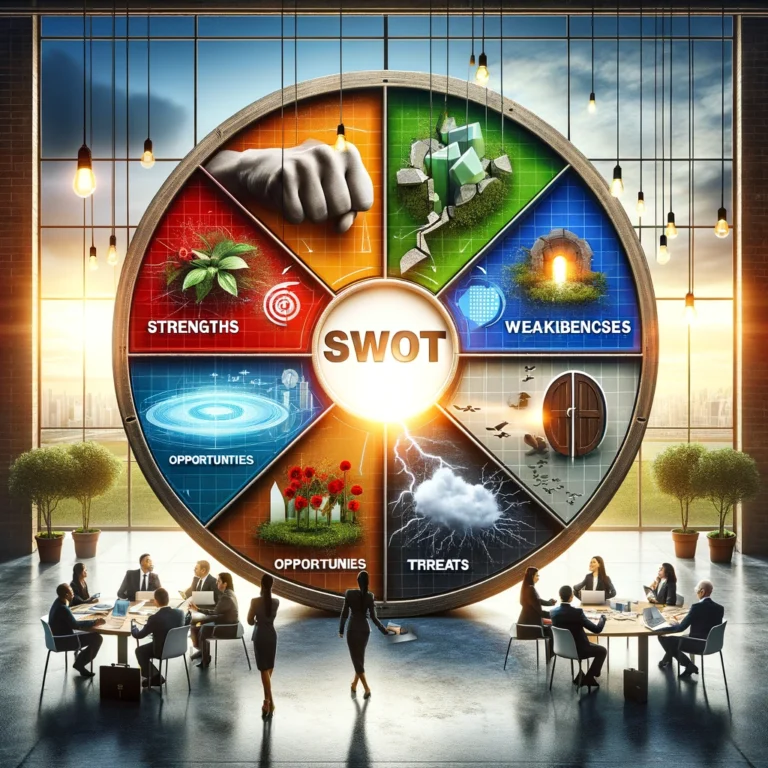SWOT analysis aims to identify the key internal strengths & weaknesses and external opportunities & threats, seen as important to achieving an objective.
The analysis of the internal strengths & weaknesses helps business owners determine their current market position, which is crucial to know before planning and implementing SMART objectives. A useful tool for:
- competitor analysis;
- assessing opportunities;
- risk assessment;
- reviewing corporate strategy;
- strategic planning.

Examples of strengths
- Products X is market leader in terms of sales.
- Customers are loyal to the brand.
Examples of weaknesses
- Workers are striking demanding higher wages.
- Machinery is obsolete, lowering production output.
SWOT Analysis is a strategic planning tool used to identify and understand the Strengths, Weaknesses, Opportunities, and Threats related to business competition or project planning. This comprehensive framework aids businesses in pinpointing internal and external factors that could impact their objectives, allowing for informed decision-making and strategy development. Understanding SWOT Analysis is crucial for IB Business & Management students, as it equips them with a critical analysis tool for evaluating business situations and making strategic decisions. This analysis explores the SWOT framework in detail, using Starbucks, a global leader in the coffee industry, as an industry example to illustrate its application.
Strengths
Definition: Strengths are internal attributes and resources that support a successful outcome. They are what the organization does well or possesses that is superior to competitors.
Example in Starbucks:
- Brand Recognition: Starbucks possesses strong brand recognition globally, synonymous with high-quality coffee and excellent customer service.
- Extensive Global Presence: With over 30,000 stores worldwide, Starbucks has a robust global footprint that allows for a broad customer base.
- Diverse Product Mix: Beyond coffee, Starbucks offers a variety of beverages, food items, and merchandise, catering to a wide range of customer preferences.
Weaknesses
Definition: Weaknesses are internal factors that detract from an organization’s ability to achieve its objectives and can be areas for improvement.
Example in Starbucks:
- High Prices: Compared to competitors, Starbucks’ pricing is on the higher side, which might alienate cost-sensitive customers.
- Dependence on the US Market: Despite its global presence, a significant portion of Starbucks’ revenues comes from the US, making it vulnerable to the country’s economic fluctuations.
Opportunities
Definition: Opportunities are external factors that the organization could exploit to its advantage, areas where the business could grow and increase its profitability.
Example in Starbucks:
- Expansion in Emerging Markets: Expanding further into emerging economies like China and India presents significant growth opportunities for Starbucks.
- Growing Demand for Specialty Coffee: The increasing consumer interest in specialty coffee offers Starbucks opportunities to introduce new and innovative products.
- Sustainability Initiatives: There is a growing consumer demand for sustainable and ethically sourced products. Starbucks can leverage its commitment to sustainability as a competitive advantage.
Threats
Definition: Threats are external challenges that could cause trouble for the business, including changes in the market landscape, economic downturns, and increased competition.
Example in Starbucks:
- Intense Competition: Starbucks faces intense competition from other coffee chains, local cafés, and fast-food restaurants offering coffee.
- Changes in Consumer Preferences: Shifts towards home brewing and consumption patterns, especially amid health concerns or economic downturns, pose a threat to Starbucks’ in-store sales.
- Global Economic Fluctuations: Economic downturns in key markets could impact consumer spending on luxury items like premium coffee.
Application and Justification
The SWOT analysis of Starbucks demonstrates how this framework can be utilized to assess a company’s strategic position and inform its strategic planning. Starbucks’ strengths like its strong brand and global presence provide a solid foundation. However, acknowledging weaknesses such as high price points and market dependence is crucial for addressing potential vulnerabilities. Opportunities for growth in emerging markets and through sustainability initiatives highlight pathways for Starbucks to expand and strengthen its market position. Meanwhile, threats from competition and changing consumer preferences necessitate strategic vigilance and adaptability.
Conclusion
SWOT Analysis offers a structured approach for organizations to assess their competitive position and strategic options. By systematically evaluating strengths, weaknesses, opportunities, and threats, businesses can develop strategies that leverage their advantages, address challenges, and capitalize on market opportunities. The Starbucks example illustrates how SWOT Analysis can guide strategic decisions, highlighting the importance of this tool in business management and planning. For IB Business & Management students, mastering SWOT Analysis provides essential skills for analyzing business scenarios, supporting strategic planning, and fostering informed decision-making in their future careers.






